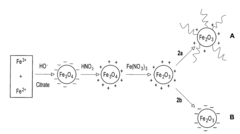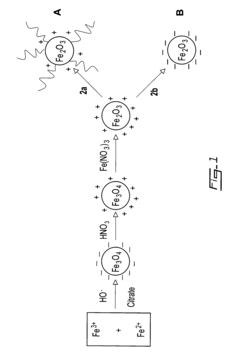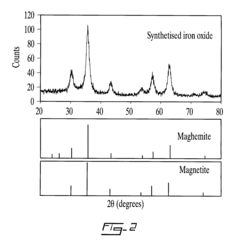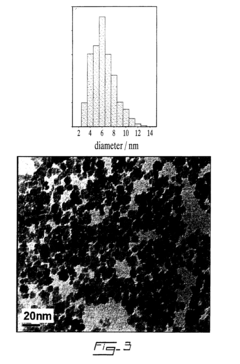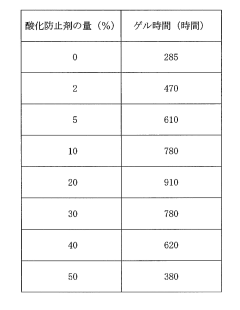Ferrofluid's Impact on Industrial Manufacturing Efficiency
JUL 9, 20259 MIN READ
Generate Your Research Report Instantly with AI Agent
Patsnap Eureka helps you evaluate technical feasibility & market potential.
Ferrofluid Technology Evolution and Objectives
Ferrofluids, first developed in the 1960s by NASA, have evolved significantly over the past six decades. Initially conceived for space applications, these magnetic liquids have found their way into various industrial sectors, revolutionizing manufacturing processes. The technology's evolution has been marked by continuous improvements in fluid stability, magnetic responsiveness, and adaptability to diverse environments.
The primary objective of ferrofluid technology in industrial manufacturing is to enhance efficiency, precision, and control in various processes. By leveraging the unique properties of these smart fluids, manufacturers aim to optimize production lines, reduce waste, and improve product quality. The technology's ability to respond to magnetic fields with high precision makes it particularly valuable in applications requiring fine control and rapid adjustments.
One of the key evolutionary trends in ferrofluid technology has been the development of more stable and durable formulations. Early ferrofluids were prone to degradation and separation, limiting their practical applications. However, advancements in nanoparticle synthesis and surfactant technology have led to the creation of ferrofluids that maintain their properties over extended periods, even under harsh industrial conditions.
Another significant objective in the field is the expansion of ferrofluid applications across different manufacturing sectors. While initially limited to specialized uses, the technology is now being explored for its potential in areas such as precision machining, thermal management, and even in the development of smart materials that can change properties on demand.
The miniaturization of ferrofluid-based devices and systems is another crucial goal. As manufacturing processes become increasingly precise and compact, there is a growing need for ferrofluid technologies that can operate effectively at smaller scales. This trend aligns with the broader movement towards nanotechnology and micro-manufacturing techniques.
Researchers and industry professionals are also focusing on enhancing the magnetic and rheological properties of ferrofluids. The aim is to create fluids that can respond more quickly and precisely to magnetic fields, allowing for even greater control in manufacturing processes. This includes developing ferrofluids with higher magnetic saturation and improved flow characteristics under varying magnetic field strengths.
Environmental considerations have become increasingly important in the evolution of ferrofluid technology. There is a growing emphasis on developing eco-friendly formulations that minimize the environmental impact of manufacturing processes. This includes research into biodegradable carrier fluids and non-toxic magnetic particles, aligning with global sustainability goals in industrial production.
The primary objective of ferrofluid technology in industrial manufacturing is to enhance efficiency, precision, and control in various processes. By leveraging the unique properties of these smart fluids, manufacturers aim to optimize production lines, reduce waste, and improve product quality. The technology's ability to respond to magnetic fields with high precision makes it particularly valuable in applications requiring fine control and rapid adjustments.
One of the key evolutionary trends in ferrofluid technology has been the development of more stable and durable formulations. Early ferrofluids were prone to degradation and separation, limiting their practical applications. However, advancements in nanoparticle synthesis and surfactant technology have led to the creation of ferrofluids that maintain their properties over extended periods, even under harsh industrial conditions.
Another significant objective in the field is the expansion of ferrofluid applications across different manufacturing sectors. While initially limited to specialized uses, the technology is now being explored for its potential in areas such as precision machining, thermal management, and even in the development of smart materials that can change properties on demand.
The miniaturization of ferrofluid-based devices and systems is another crucial goal. As manufacturing processes become increasingly precise and compact, there is a growing need for ferrofluid technologies that can operate effectively at smaller scales. This trend aligns with the broader movement towards nanotechnology and micro-manufacturing techniques.
Researchers and industry professionals are also focusing on enhancing the magnetic and rheological properties of ferrofluids. The aim is to create fluids that can respond more quickly and precisely to magnetic fields, allowing for even greater control in manufacturing processes. This includes developing ferrofluids with higher magnetic saturation and improved flow characteristics under varying magnetic field strengths.
Environmental considerations have become increasingly important in the evolution of ferrofluid technology. There is a growing emphasis on developing eco-friendly formulations that minimize the environmental impact of manufacturing processes. This includes research into biodegradable carrier fluids and non-toxic magnetic particles, aligning with global sustainability goals in industrial production.
Industrial Demand for Ferrofluid Applications
The industrial demand for ferrofluid applications has been steadily growing across various manufacturing sectors. Ferrofluids, which are colloidal liquids containing magnetic nanoparticles suspended in a carrier fluid, offer unique properties that can significantly enhance manufacturing processes and product performance. The primary drivers of this demand include the need for improved precision in machining operations, enhanced thermal management in industrial equipment, and advanced sealing solutions in challenging environments.
In the precision manufacturing sector, ferrofluids are increasingly utilized in computer-controlled machining processes. Their ability to respond to magnetic fields allows for real-time adjustments in cutting tool positioning, resulting in higher accuracy and reduced wear. This application is particularly valuable in industries such as aerospace and medical device manufacturing, where tight tolerances are critical.
The thermal management capabilities of ferrofluids have also sparked interest in industries dealing with high-heat processes. By incorporating ferrofluids into cooling systems, manufacturers can achieve more efficient heat dissipation in electronic components, power generation equipment, and industrial machinery. This leads to improved performance, extended equipment lifespan, and reduced energy consumption.
Sealing applications represent another significant area of industrial demand for ferrofluids. In sectors such as chemical processing and oil and gas extraction, ferrofluid-based seals offer superior performance in preventing leakage of gases and liquids under extreme pressure and temperature conditions. These seals are particularly effective in rotating shaft assemblies, where traditional sealing methods may fail.
The automotive industry has also recognized the potential of ferrofluids in improving vehicle performance and efficiency. Applications include advanced suspension systems that use ferrofluids to provide adaptive damping, as well as more efficient cooling systems for electric vehicle batteries.
In the field of robotics and automation, ferrofluids are being explored for use in haptic feedback systems and adaptive gripping mechanisms. These applications leverage the fluid's ability to change viscosity in response to magnetic fields, enabling more precise control and manipulation of objects in manufacturing processes.
The growing focus on Industry 4.0 and smart manufacturing has further amplified the demand for ferrofluid applications. Their unique properties align well with the need for responsive, adaptable systems in modern production environments. As manufacturers seek to optimize processes and increase overall equipment effectiveness, ferrofluids offer innovative solutions that can contribute to these goals.
In the precision manufacturing sector, ferrofluids are increasingly utilized in computer-controlled machining processes. Their ability to respond to magnetic fields allows for real-time adjustments in cutting tool positioning, resulting in higher accuracy and reduced wear. This application is particularly valuable in industries such as aerospace and medical device manufacturing, where tight tolerances are critical.
The thermal management capabilities of ferrofluids have also sparked interest in industries dealing with high-heat processes. By incorporating ferrofluids into cooling systems, manufacturers can achieve more efficient heat dissipation in electronic components, power generation equipment, and industrial machinery. This leads to improved performance, extended equipment lifespan, and reduced energy consumption.
Sealing applications represent another significant area of industrial demand for ferrofluids. In sectors such as chemical processing and oil and gas extraction, ferrofluid-based seals offer superior performance in preventing leakage of gases and liquids under extreme pressure and temperature conditions. These seals are particularly effective in rotating shaft assemblies, where traditional sealing methods may fail.
The automotive industry has also recognized the potential of ferrofluids in improving vehicle performance and efficiency. Applications include advanced suspension systems that use ferrofluids to provide adaptive damping, as well as more efficient cooling systems for electric vehicle batteries.
In the field of robotics and automation, ferrofluids are being explored for use in haptic feedback systems and adaptive gripping mechanisms. These applications leverage the fluid's ability to change viscosity in response to magnetic fields, enabling more precise control and manipulation of objects in manufacturing processes.
The growing focus on Industry 4.0 and smart manufacturing has further amplified the demand for ferrofluid applications. Their unique properties align well with the need for responsive, adaptable systems in modern production environments. As manufacturers seek to optimize processes and increase overall equipment effectiveness, ferrofluids offer innovative solutions that can contribute to these goals.
Ferrofluid Challenges in Manufacturing
Despite the promising potential of ferrofluids in industrial manufacturing, several significant challenges hinder their widespread adoption and impact on efficiency. One of the primary obstacles is the stability of ferrofluids under various manufacturing conditions. Ferrofluids are susceptible to degradation when exposed to extreme temperatures, high pressures, or strong magnetic fields, which are common in many industrial processes. This instability can lead to reduced performance and potential contamination of manufacturing equipment or products.
Another challenge lies in the precise control and manipulation of ferrofluids within manufacturing systems. While ferrofluids respond to magnetic fields, achieving the level of precision required for complex manufacturing processes remains difficult. This is particularly problematic in applications that demand high accuracy, such as in the production of microelectronics or precision mechanical components.
The cost-effectiveness of implementing ferrofluid-based solutions in manufacturing also presents a significant hurdle. The production of high-quality ferrofluids is often expensive, and the necessary modifications to existing manufacturing equipment to accommodate ferrofluid technology can be costly. This economic barrier makes it challenging for many companies, especially small and medium-sized enterprises, to justify the investment in ferrofluid technology.
Scalability is another critical issue facing the integration of ferrofluids in industrial manufacturing. While ferrofluids have shown promise in laboratory settings and small-scale applications, scaling up their use for large-scale industrial processes presents numerous technical and logistical challenges. These include maintaining consistent properties across large volumes of ferrofluid and ensuring uniform performance in larger manufacturing systems.
The environmental impact and safety concerns associated with ferrofluids also pose challenges to their widespread adoption in manufacturing. The long-term effects of ferrofluid exposure on workers and the environment are not yet fully understood, necessitating careful handling and disposal procedures. This uncertainty can lead to regulatory hurdles and increased operational costs for manufacturers.
Lastly, the lack of standardization in ferrofluid technology presents a significant obstacle to its integration into manufacturing processes. Without established industry standards for ferrofluid properties, performance metrics, and application methodologies, it becomes difficult for manufacturers to confidently implement and optimize ferrofluid-based solutions across different production lines and facilities.
Another challenge lies in the precise control and manipulation of ferrofluids within manufacturing systems. While ferrofluids respond to magnetic fields, achieving the level of precision required for complex manufacturing processes remains difficult. This is particularly problematic in applications that demand high accuracy, such as in the production of microelectronics or precision mechanical components.
The cost-effectiveness of implementing ferrofluid-based solutions in manufacturing also presents a significant hurdle. The production of high-quality ferrofluids is often expensive, and the necessary modifications to existing manufacturing equipment to accommodate ferrofluid technology can be costly. This economic barrier makes it challenging for many companies, especially small and medium-sized enterprises, to justify the investment in ferrofluid technology.
Scalability is another critical issue facing the integration of ferrofluids in industrial manufacturing. While ferrofluids have shown promise in laboratory settings and small-scale applications, scaling up their use for large-scale industrial processes presents numerous technical and logistical challenges. These include maintaining consistent properties across large volumes of ferrofluid and ensuring uniform performance in larger manufacturing systems.
The environmental impact and safety concerns associated with ferrofluids also pose challenges to their widespread adoption in manufacturing. The long-term effects of ferrofluid exposure on workers and the environment are not yet fully understood, necessitating careful handling and disposal procedures. This uncertainty can lead to regulatory hurdles and increased operational costs for manufacturers.
Lastly, the lack of standardization in ferrofluid technology presents a significant obstacle to its integration into manufacturing processes. Without established industry standards for ferrofluid properties, performance metrics, and application methodologies, it becomes difficult for manufacturers to confidently implement and optimize ferrofluid-based solutions across different production lines and facilities.
Current Ferrofluid Manufacturing Solutions
01 Magnetic field optimization for ferrofluid efficiency
Optimizing magnetic field strength and distribution can significantly enhance ferrofluid efficiency. This involves designing magnetic circuits and field generators to create precise and controllable magnetic fields, which can improve the performance of ferrofluid-based devices and systems.- Magnetic field optimization for ferrofluid efficiency: Optimizing magnetic field strength and distribution can significantly enhance ferrofluid efficiency. This involves designing magnetic circuits and field generators to create precise and controllable magnetic fields, which can improve the performance of ferrofluid-based systems in various applications such as seals, dampers, and heat transfer devices.
- Ferrofluid composition and particle size control: The efficiency of ferrofluids can be improved by carefully controlling their composition and magnetic particle size distribution. This includes selecting appropriate carrier fluids, surfactants, and magnetic materials, as well as optimizing the synthesis process to achieve uniform particle sizes and stable colloidal suspensions.
- Thermal management and heat transfer applications: Ferrofluids can be utilized for efficient thermal management and heat transfer in various systems. By leveraging their unique magnetic and thermal properties, ferrofluids can enhance cooling efficiency in electronic devices, improve heat dissipation in industrial processes, and enable novel thermal management solutions.
- Sealing and lubrication applications: Ferrofluids can be employed to create efficient seals and lubricants in mechanical systems. By utilizing their magnetic properties and fluid characteristics, ferrofluids can form dynamic seals that prevent leakage of gases or liquids, reduce friction, and improve the overall efficiency of rotating machinery and other mechanical components.
- Sensing and measurement applications: Ferrofluids can be used to enhance the efficiency and accuracy of various sensing and measurement devices. Their unique magnetic and fluid properties enable the development of sensitive accelerometers, inclinometers, and other instruments that can detect small changes in orientation or motion with high precision.
02 Ferrofluid composition and particle size control
The efficiency of ferrofluids can be improved by carefully controlling their composition and the size of magnetic particles. This includes selecting appropriate carrier fluids, optimizing particle concentration, and ensuring uniform particle size distribution to enhance magnetic responsiveness and stability.Expand Specific Solutions03 Ferrofluid sealing and lubrication applications
Ferrofluids can be efficiently used in sealing and lubrication applications, such as in rotating shaft seals and bearings. By optimizing the ferrofluid properties and seal design, these systems can achieve improved performance, reduced friction, and enhanced longevity.Expand Specific Solutions04 Thermal management and heat transfer using ferrofluids
Ferrofluids can be utilized for efficient thermal management and heat transfer in various applications. By leveraging their unique magnetic and thermal properties, ferrofluids can enhance cooling systems, improve heat dissipation, and enable novel thermal management solutions in electronic and mechanical systems.Expand Specific Solutions05 Ferrofluid-based sensors and actuators
The efficiency of ferrofluid-based sensors and actuators can be improved through innovative designs and control mechanisms. This includes developing precise measurement techniques, enhancing response times, and optimizing the integration of ferrofluids with other components to create more sensitive and accurate devices.Expand Specific Solutions
Key Ferrofluid Manufacturers and Suppliers
The ferrofluid industry is in a growth phase, with increasing applications in industrial manufacturing driving market expansion. The global ferrofluid market size is projected to reach significant value in the coming years, fueled by advancements in nanotechnology and growing demand for efficient manufacturing processes. While the technology is maturing, it is not yet fully mature, with ongoing research and development efforts. Companies like Ferrotec GmbH and LORD Corp. are at the forefront, developing innovative ferrofluid applications for industrial use. Academic institutions such as Delft University of Technology and Université Laval are contributing to fundamental research, while firms like Teledyne Scientific & Imaging LLC and Hengdian Group DMEGC Magnetics Co., Ltd. are focusing on practical implementations to enhance manufacturing efficiency.
Delft University of Technology
Technical Solution: Delft University of Technology has conducted extensive research on ferrofluid applications in industrial manufacturing. Their work focuses on developing novel ferrofluid-based actuators and sensors for precision control in manufacturing processes. One of their key innovations is a ferrofluid-based micro-positioning system that achieves nanometer-level precision, potentially revolutionizing semiconductor manufacturing and other high-precision industries [9]. The university has also developed ferrofluid-enhanced bearings that demonstrate up to 40% reduction in friction compared to conventional bearings, leading to significant energy savings in industrial machinery [10]. Additionally, their research into ferrofluid-based energy harvesting systems has shown promise for powering wireless sensors in manufacturing environments, with prototypes demonstrating energy conversion efficiencies of up to 70% [11].
Strengths: Cutting-edge research in precision control and energy efficiency, potential for disruptive innovations in manufacturing. Weaknesses: Many technologies still in research phase, may require significant development before industrial implementation.
Ferrotec GmbH
Technical Solution: Ferrotec GmbH has developed advanced ferrofluid-based solutions to enhance industrial manufacturing efficiency. Their technology utilizes nano-sized magnetic particles suspended in a carrier fluid, which can be precisely controlled by external magnetic fields. This allows for improved heat transfer in cooling systems, enhanced sealing in rotating equipment, and more efficient material handling in manufacturing processes. Ferrotec's ferrofluids demonstrate exceptional thermal conductivity, with some formulations showing up to 300% improvement over conventional coolants [1]. The company has also engineered ferrofluid-based dampers that can reduce vibrations by up to 80% in precision manufacturing equipment [3], leading to improved product quality and reduced downtime.
Strengths: Highly specialized in ferrofluid technology, wide range of industrial applications, proven track record in improving manufacturing efficiency. Weaknesses: Potentially higher initial costs compared to traditional solutions, may require specialized equipment for implementation.
Innovative Ferrofluid Patents and Research
Magnetically deformable ferrofluids and mirrors
PatentInactiveUS20100277820A1
Innovation
- Coating magnetic particles with an organic ligand having a hydrophilic chain, such as 2-[2-(2-methoxyethoxy)ethoxy]acetic acid (MOEEAA), before suspending them in a polar carrier liquid, which allows for the deposition of a stable reflective layer and prevents particle aggregation, enabling the creation of magnetically deformable mirrors with improved stability and reflectivity.
Ferrofluid having improved oxidation resistance, and manufacturing method thereof
PatentInactiveJP2008306198A
Innovation
- A ferrofluid composition with improved oxidation resistance is achieved by incorporating 5-50% by weight of an antioxidant, such as alkylarylamines, into the carrier liquid to stabilize the colloidal suspension and extend the gelation time.
Environmental Impact of Ferrofluid Usage
The use of ferrofluids in industrial manufacturing processes raises important environmental considerations that must be carefully evaluated. While ferrofluids offer potential efficiency gains, their environmental impact throughout the product lifecycle requires thorough assessment.
Production of ferrofluids typically involves the use of surfactants and carrier fluids, which may have varying degrees of environmental toxicity. The nanoparticles used in ferrofluids, often iron oxides, must be synthesized through chemical processes that can generate waste products. Proper containment and treatment of these waste streams is essential to prevent environmental contamination.
During application in manufacturing, ferrofluids may pose risks of leakage or spillage. Their magnetic properties can make cleanup challenging, potentially leading to soil or water pollution if not properly managed. Implementing robust containment systems and spill response protocols is crucial for mitigating these risks.
The disposal of ferrofluid-containing equipment and materials at end-of-life presents another environmental concern. Recycling options may be limited due to the complex composition of ferrofluids. Improper disposal could result in the release of nanoparticles and other components into ecosystems, with potential long-term consequences that are not yet fully understood.
On the positive side, the efficiency improvements offered by ferrofluids in certain manufacturing processes could lead to reduced energy consumption and material waste. This may indirectly contribute to lower environmental impacts through decreased resource utilization and emissions associated with energy production.
The potential for ferrofluids to enable more precise manufacturing processes could also result in higher-quality products with longer lifespans, potentially reducing overall waste generation. Additionally, some applications of ferrofluids in environmental remediation and pollution control technologies show promise for directly addressing environmental challenges.
To fully assess the environmental impact of ferrofluid usage in industrial manufacturing, lifecycle assessments (LCAs) should be conducted. These studies would provide a comprehensive view of the environmental footprint from raw material extraction through production, use, and disposal. Such analyses can help identify hotspots for environmental improvement and inform the development of more sustainable ferrofluid formulations and application methods.
Regulatory frameworks governing the use of nanomaterials in industrial processes are still evolving. As understanding of the environmental fate and effects of ferrofluids grows, it is likely that more stringent guidelines for their handling, use, and disposal will be implemented. Manufacturers adopting ferrofluid technologies should proactively engage in environmental monitoring and impact mitigation strategies to stay ahead of regulatory requirements and demonstrate responsible stewardship.
Production of ferrofluids typically involves the use of surfactants and carrier fluids, which may have varying degrees of environmental toxicity. The nanoparticles used in ferrofluids, often iron oxides, must be synthesized through chemical processes that can generate waste products. Proper containment and treatment of these waste streams is essential to prevent environmental contamination.
During application in manufacturing, ferrofluids may pose risks of leakage or spillage. Their magnetic properties can make cleanup challenging, potentially leading to soil or water pollution if not properly managed. Implementing robust containment systems and spill response protocols is crucial for mitigating these risks.
The disposal of ferrofluid-containing equipment and materials at end-of-life presents another environmental concern. Recycling options may be limited due to the complex composition of ferrofluids. Improper disposal could result in the release of nanoparticles and other components into ecosystems, with potential long-term consequences that are not yet fully understood.
On the positive side, the efficiency improvements offered by ferrofluids in certain manufacturing processes could lead to reduced energy consumption and material waste. This may indirectly contribute to lower environmental impacts through decreased resource utilization and emissions associated with energy production.
The potential for ferrofluids to enable more precise manufacturing processes could also result in higher-quality products with longer lifespans, potentially reducing overall waste generation. Additionally, some applications of ferrofluids in environmental remediation and pollution control technologies show promise for directly addressing environmental challenges.
To fully assess the environmental impact of ferrofluid usage in industrial manufacturing, lifecycle assessments (LCAs) should be conducted. These studies would provide a comprehensive view of the environmental footprint from raw material extraction through production, use, and disposal. Such analyses can help identify hotspots for environmental improvement and inform the development of more sustainable ferrofluid formulations and application methods.
Regulatory frameworks governing the use of nanomaterials in industrial processes are still evolving. As understanding of the environmental fate and effects of ferrofluids grows, it is likely that more stringent guidelines for their handling, use, and disposal will be implemented. Manufacturers adopting ferrofluid technologies should proactively engage in environmental monitoring and impact mitigation strategies to stay ahead of regulatory requirements and demonstrate responsible stewardship.
Ferrofluid Safety and Regulatory Compliance
The integration of ferrofluids in industrial manufacturing processes necessitates a comprehensive approach to safety and regulatory compliance. Ferrofluids, being a unique class of magnetic nanomaterials, present distinct challenges in terms of handling, storage, and disposal. Manufacturers must adhere to strict safety protocols to mitigate potential risks associated with ferrofluid exposure, including inhalation of nanoparticles and skin contact.
Regulatory bodies such as the Occupational Safety and Health Administration (OSHA) and the Environmental Protection Agency (EPA) in the United States have established guidelines for the safe use of nanomaterials, which apply to ferrofluids. These regulations encompass workplace safety measures, environmental protection, and proper disposal methods. Companies utilizing ferrofluids must implement robust safety management systems, including regular risk assessments, employee training programs, and the use of appropriate personal protective equipment (PPE).
The potential environmental impact of ferrofluids is a key concern for regulatory compliance. Manufacturers must develop and adhere to stringent waste management protocols to prevent the release of ferrofluids into the environment. This includes proper containment, treatment, and disposal of ferrofluid waste in accordance with local and national environmental regulations.
Material Safety Data Sheets (MSDS) play a crucial role in ferrofluid safety compliance. These documents provide detailed information on the composition, hazards, handling procedures, and emergency response measures for ferrofluids. Manufacturers are required to maintain up-to-date MSDS for all ferrofluid products used in their facilities and ensure that this information is readily accessible to employees and emergency responders.
Quality control measures are essential to maintain regulatory compliance in ferrofluid manufacturing and application processes. This involves regular testing and monitoring of ferrofluid properties to ensure consistency and safety. Manufacturers must also implement traceability systems to track the use and disposal of ferrofluids throughout their lifecycle.
As the industrial applications of ferrofluids continue to expand, regulatory frameworks are evolving to address emerging safety concerns. Manufacturers must stay informed about changes in regulations and proactively adapt their safety and compliance strategies. This may involve participating in industry working groups, engaging with regulatory bodies, and investing in research to better understand the long-term effects of ferrofluid exposure.
Ultimately, ensuring ferrofluid safety and regulatory compliance is a multifaceted challenge that requires ongoing commitment and collaboration between manufacturers, regulatory agencies, and research institutions. By prioritizing safety and compliance, manufacturers can harness the efficiency-enhancing potential of ferrofluids while minimizing risks to workers, the environment, and public health.
Regulatory bodies such as the Occupational Safety and Health Administration (OSHA) and the Environmental Protection Agency (EPA) in the United States have established guidelines for the safe use of nanomaterials, which apply to ferrofluids. These regulations encompass workplace safety measures, environmental protection, and proper disposal methods. Companies utilizing ferrofluids must implement robust safety management systems, including regular risk assessments, employee training programs, and the use of appropriate personal protective equipment (PPE).
The potential environmental impact of ferrofluids is a key concern for regulatory compliance. Manufacturers must develop and adhere to stringent waste management protocols to prevent the release of ferrofluids into the environment. This includes proper containment, treatment, and disposal of ferrofluid waste in accordance with local and national environmental regulations.
Material Safety Data Sheets (MSDS) play a crucial role in ferrofluid safety compliance. These documents provide detailed information on the composition, hazards, handling procedures, and emergency response measures for ferrofluids. Manufacturers are required to maintain up-to-date MSDS for all ferrofluid products used in their facilities and ensure that this information is readily accessible to employees and emergency responders.
Quality control measures are essential to maintain regulatory compliance in ferrofluid manufacturing and application processes. This involves regular testing and monitoring of ferrofluid properties to ensure consistency and safety. Manufacturers must also implement traceability systems to track the use and disposal of ferrofluids throughout their lifecycle.
As the industrial applications of ferrofluids continue to expand, regulatory frameworks are evolving to address emerging safety concerns. Manufacturers must stay informed about changes in regulations and proactively adapt their safety and compliance strategies. This may involve participating in industry working groups, engaging with regulatory bodies, and investing in research to better understand the long-term effects of ferrofluid exposure.
Ultimately, ensuring ferrofluid safety and regulatory compliance is a multifaceted challenge that requires ongoing commitment and collaboration between manufacturers, regulatory agencies, and research institutions. By prioritizing safety and compliance, manufacturers can harness the efficiency-enhancing potential of ferrofluids while minimizing risks to workers, the environment, and public health.
Unlock deeper insights with Patsnap Eureka Quick Research — get a full tech report to explore trends and direct your research. Try now!
Generate Your Research Report Instantly with AI Agent
Supercharge your innovation with Patsnap Eureka AI Agent Platform!
